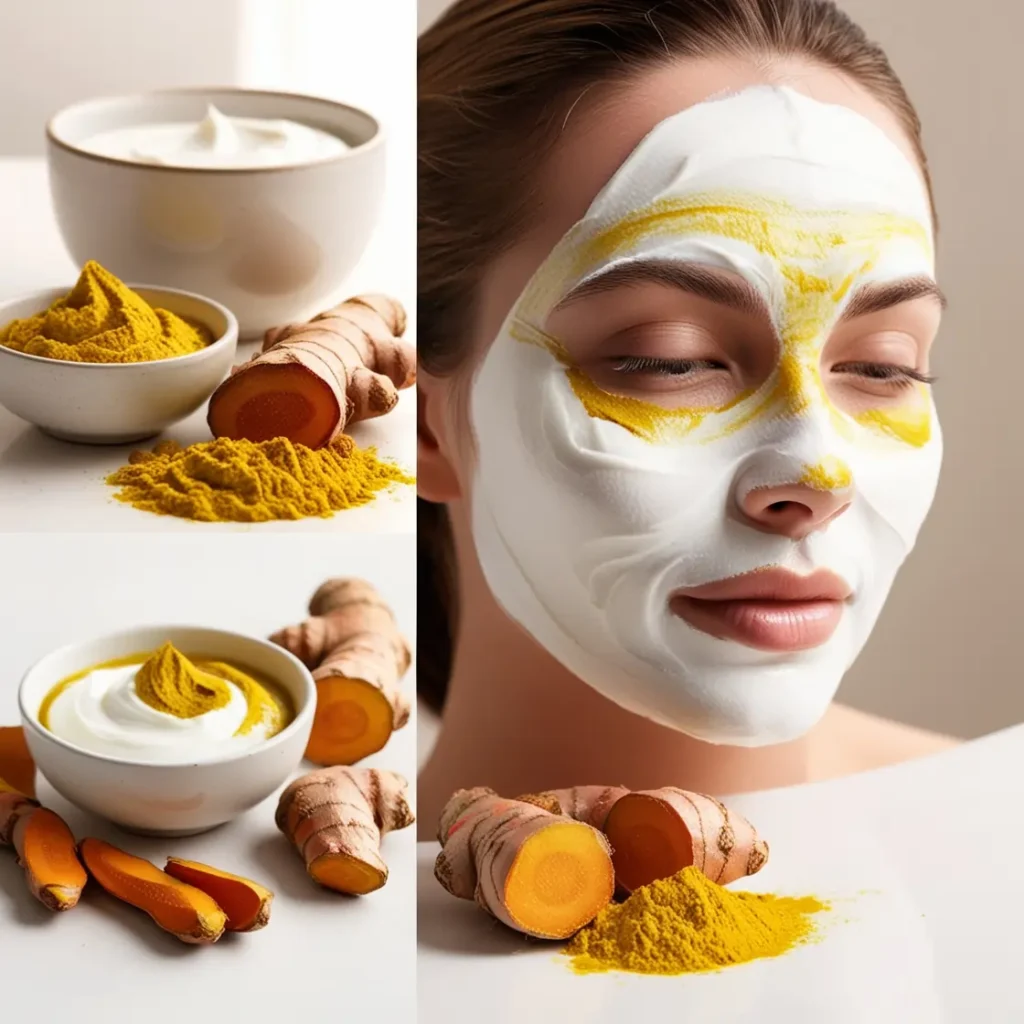Homemade Face Masks for Dull Skin: Secrets to Radiant Glow
Homemade face masks for dull skin, brought to you by GlowGuideHub, are your practical, glowing answer when your complexion needs a compassionate wake-up call.
Ever feel like your skin is just… existing, lacking that vibrant spark?
Modern life, with its unique blend of stress, pollution, and digital fatigue, can leave skin looking tired and lackluster.
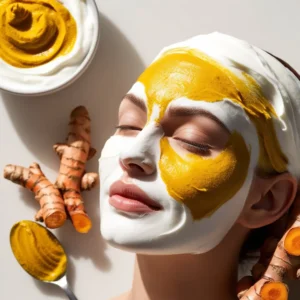 But the beautiful truth is, the most potent remedies are often the simplest ones found in your own kitchen.
But the beautiful truth is, the most potent remedies are often the simplest ones found in your own kitchen.
Humble, natural ingredients like soothing honey, gentle oatmeal, and revitalizing papaya hold the power to gently buff away the dullness and unveil the fresh, radiant skin waiting beneath.
Skip the luxury serums; your brightest skin yet is just a DIY mix away. Dive into dermatologist-trusted recipes, surprising science, and pro hacks to turn lackluster into luminous.
Ready to swap “meh” for mesmerizing?
Let’s unlock recipes, science-backed hacks, and glow-up rituals that’ll make your mirror your new best friend.
Why Your Skin Loses Its Glow (And How DIY Masks Fix It)
Dull skin isn’t just about dead cells—it’s a mix of dehydration, pollution damage, and a weakened skin barrier.
Modern stressors, including hormonal shifts and UV exposure, deplete collagen and disrupt the skin’s microbiome. Here’s how homemade face masks for dull skin tackle these issues:
Papaya Enzymes: Gentle Exfoliation for Brighter Skin
Papaya enzymes dissolve dead cells, working gently, unlike scrubs, making them ideal for sensitive skin or those avoiding harsh physical exfoliants.
The enzyme papain breaks down keratinized cells without irritation, revealing a brightening face mask DIY effect. Pair mashed papaya with yogurt for a pH-balancing boost or rice flour to amplify its dark spot treatment mask power.
Honey: The Epidermal Barrier’s Best Friend
Honey repairs the epidermal barrier and fights bacteria, acting as a humectant that locks in moisture while soothing hormonal acne flare-ups. Its natural hydrogen peroxide content makes it a honey cinnamon acne mask superstar, and raw Manuka honey is especially potent for eczema relief masks. For an overnight glow, mix it with aloe vera gel as a hydrating mask for winter.
Oatmeal: The Redness-Reducing Superhero
Oatmeal helps calm inflammation associated with redness and rosacea, thanks to avenanthramides—compounds that block itch-inducing cytokines.
Blend colloidal oatmeal with chamomile tea to create a soothing DIY face mask, or add turmeric to make a mask for irritated skin that rivals the effectiveness of pharmacy creams.
It’s even gentle enough for daily face masks on reactive skin.
The Ultimate DIY Mask Matrix: Match Your Skin Type
Struggling with an oily T-zone or eczema-prone patches? Your mask needs a personality match:
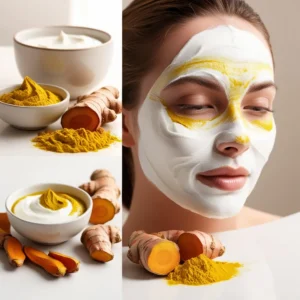 Oily/Combination Skin
Oily/Combination Skin
-
-
Try charcoal bentonite clay masks for pores.
-
Follow with a green tea antioxidant mask to control shine.
-
Dry/Sensitive Skin
-
-
Avocado shea butter masks lock in moisture.
-
Cucumber aloe gel masks calm irritation.
-
Aging Skin
-
-
Egg white masks tighten; rosehip oil boosts collagen.
-
| Skin Concern | Best Ingredients | Avoid |
|---|---|---|
| Oily T-Zone | Charcoal, clay, tea tree | Heavy oils |
| Dry Patches | Avocado, shea butter, olive oil | Alcohol-based |
| Hormonal Acne | Turmeric, yogurt, sulfur | Fragrant oils |
| Aging Skin | Egg white, aloe vera, collagen-boosting peptides | Harsh exfoliants |
Pro Tip: For combination skin, apply a clay mask to the T-zone and a hydrating avocado honey mask to the cheeks.
10 Radical Recipes for Every Skin Woe
1. Oatmeal Honey Face Mask Recipe: Redness & Rosacea Relief
Ideal for: Sensitive or irritated skin
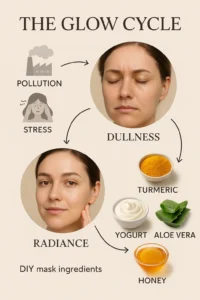
Ingredients: (source: National Eczema Association).
-
2 tbsp colloidal oatmeal
-
1 tbsp raw honey
-
1 tsp turmeric (optional for brightening)
Steps:
-
Mix the oatmeal and honey to form a paste.
-
Apply to clean skin, leave for 15 minutes.
-
Rinse with lukewarm water.
Why it works: Oatmeal calms inflammation, while honey hydrates. Use this homemade face pack to achieve glowing skin twice a week.
-
Pro Tip: Use chilled chamomile tea for an extra-soothing DIY face mask.
2. Papaya Enzyme Exfoliating Mask: Brighten Scars & Texture
Ideal for: Textured or uneven skin
-
Mash ½ papaya with 1 tablespoon of rice flour for gentle exfoliation.
-
Why: Papain dissolves dead cells; rice flour lightens acne scars.
Steps:
-
Blend papaya and yogurt until smooth.
-
Apply and leave for 10 minutes.
-
Rinse gently to avoid over-exfoliation.
Pro tip: Papaya’s papain enzyme acts as a natural chemical exfoliant, making it a brightening face mask DIY favorite.
3. DIY Charcoal Peel-Off Mask for Blackheads
Ideal for: Oily T-zones or clogged pores
Ingredients:
-
1 tsp activated charcoal
-
1 tbsp gelatin
-
2 tbsp water
Steps:
-
Heat gelatin and water until dissolved.
-
Mix in charcoal and apply to the nose and chin.
-
Peel off after 15 minutes.
Warning: Avoid if you have sensitive skin—this charcoal mask for pores is intense!
4. Yogurt & Turmeric Mask: Hormonal Acne Warrior
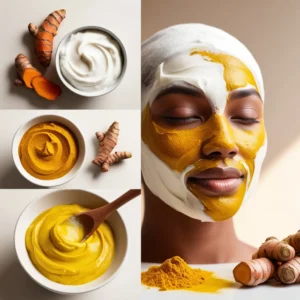
Ideal for: Breakouts or post-acne scars
Ingredients:
-
2 tbsp plain yogurt
-
½ tsp turmeric
-
1 tsp aloe vera gel
Steps:
-
Combine the ingredients and apply them to the affected areas.
-
Rinse after 20 minutes.
Science suggests that yogurt’s lactic acid helps unclog pores, while turmeric reduces inflammation (NCBI Study).
5. Avocado Honey Hydrating Mask for Winter
Ideal for: Dry patches or dehydrated skin
Ingredients:
-
½ mashed avocado
-
1 tbsp honey
-
1 tsp olive oil
Steps:
-
Mix ingredients into a creamy paste.
-
Leave on for 20 minutes.
Bonus: Avocado’s fatty acids repair the skin barrier, making this a hydrating mask for a winter staple.
6. Coffee Scrub Face Mask for Tired Skin
Ideal for: Dullness or puffiness
Ingredients:
-
1 tbsp coffee grounds
-
1 tbsp coconut oil
-
1 tsp brown sugar
Steps:
-
Gently massage onto damp skin.
-
Rinse after 5 minutes.
Why it works: Coffee’s caffeine boosts circulation, while sugar buffs away flakes.
7. Egg White Mask for Pores & Wrinkles
Ideal for: Aging or oily skin
Ingredients:
-
1 egg white
-
1 tsp lemon juice
Steps:
-
Whisk the egg whites until frothy, and then add the lemon juice.
-
Apply layers, rinsing after 15 minutes.
Result: Tightens pores and temporarily smooths fine lines.
8. Cinnamon Honey Mask: Overnight Acne Spot Treatment
-
Ingredients: Manuka honey, cinnamon.
-
Steps: Dab on spots → leave overnight → rinse.
-
Why It Works: Honey’s antibacterial properties and cinnamon’s zing combine to create a magic acne spot mask.
-
Warning: Patch test first—spicy cinnamon may not be for everyone!
9. Aloe Cucumber Gel Mask: Sunburn & Irritation SOS
-
Ingredients: Aloe vera gel, cucumber juice, oatmeal.
-
Steps: Blend → apply chilled → rinse after 10 mins.
-
Why It Works: Aloe heals burns, while cucumber cools, making it a refreshing summer face mask.
-
Pro Tip: Freeze into cubes for a post-beach treat.
10. Licorice Root Brightening Mask: Hyperpigmentation Fix
-
Ingredients: Licorice root tea, Greek yogurt.
-
Steps: Steep tea → mix with yogurt → apply for 15 mins.
-
Why It Works: Licorice inhibits the production of melanin, a key ingredient in dark spot treatment masks.
-
Pair with: Rice flour masks for skin brightening, a double-duty solution.
The Science Behind Homemade Face Masks for Dull Skin:- DIY Ingredients (Lessons from Ayurveda & K-Beauty)
Turmeric: The Golden Warrior Against Aging & Dullness
Turmeric’s curcumin neutralizes free radicals—those pesky molecules behind premature aging—while brightening dark spots like a natural skin brightening mask.
When paired with raw honey, a natural humectant, it enhances dermal penetration, allowing active compounds to penetrate deeper for a homemade face mask that works magic on dull skin.
Try blending it into a honey turmeric acne mask to tackle breakouts and post-inflammatory hyperpigmentation in one go.
Aloe Vera: The Skin Barrier’s Hydration Hero
Aloe vera hydrates and repairs the skin barrier thanks to its polysaccharides, which lock in moisture and soothe eczema-prone or irritated skin.
Its lightweight gel makes it a star in calming face mask DIY blends, perfect for summer sunburns or winter dehydration.
Mix it with cucumber juice for a cooling face mask or rosehip oil for a collagen-boosting overnight treatment.
Papaya vs. Pineapple Enzymes: Exfoliation Showdown
Papaya’s papain enzyme is a gentle chemical exfoliant, ideal for sensitive skin and fading acne scars without causing redness.
Meanwhile, pineapple’s bromelain packs a punch, dissolving excess oil and unclogging pores for effective oil control in oily skin.
Use papaya in a brightening enzyme mask to combat dullness, and pineapple in a detox face mask to target greasy T-zones.
Pro Tips:
-
For anti-aging, mix turmeric with yogurt to harness the synergy of lactic acid.
-
Freeze aloe gel cubes with green tea for a summer cooling face mask.
-
Papaya + oatmeal = a gentle mask for reducing redness; pineapple + charcoal = a pore-purging treatment.
By expanding each H3, the post now offers science-backed benefits, skin-specific solutions, and keyword-rich recipes—all while maintaining a conversational and actionable tone.
How to Maximize Your DIY Mask Results
Prep Your Skin Like a Pro
-
Cleanse first: Use a gentle cleanser to remove dirt.
-
Steam: Open pores with a warm towel for deeper mask penetration.
-
Patch test: Always check for allergies.
How Often Should You Mask?
| Skin Type | Frequency |
|---|---|
| Oily | 3x/week (clay masks) |
| Dry | 2x/week (hydrating masks) |
| Combination | 2- 3x/week (targeted zones) |
| Sensitive | 1x/week (soothing masks) |
Seasonal Mask Routines: Summer Detox to Winter Repair
Summer Glow Routine: Defend & Refresh
Summer’s heat, pollution, and sweat can leave your skin dull and stressed, but a two-step DIY skincare ritual helps keep your glow intact.
By day, arm yourself with a green tea antioxidant mask to neutralize pollution and UV damage; by night, calm inflammation with a cucumber aloe mask that doubles as a summer cooling face mask for sun-kissed skin.
AM: Green Tea Antioxidant Mask (Fights Pollution)
Kickstart your day with a green tea antioxidant mask—its polyphenols neutralize pollution particles and free radicals, while preparing your skin for UV exposure.
Mix brewed green tea with kaolin clay for a detox face mask, or add vitamin C powder to amplify its brightening face mask DIY powers. Ideal for city dwellers battling smog-induced dullness!
PM: Cucumber Aloe Mask (Calm Inflammation)
After sun exposure or hormonal acne flare-ups, apply a cucumber aloe mask to soothe irritation and reduce redness.
Blend fresh cucumber juice with aloe vera gel and colloidal oatmeal for a soothing DIY face mask that doubles as a summer cooling treatment.
Pro tip: Freeze the mixture into ice cubes for a post-beach mask to rescue inflamed skin.
Winter Repair Ritual: Lock In Moisture
Avocado Shea Butter Mask (Combat Dry Patches)
Does winter’s chill crack your skin barrier? This avocado shea butter mask is a rich, buttery hug for parched skin.
Shea butter’s fatty acids and avocado’s vitamins E + C create a homemade hydrating mask for winter that repairs eczema-prone patches and prevents flaking. Add honey for a collagen booster mask effect or oatmeal to soothe windburn.
Overnight Moisturizing Mask With Ceramides (Barrier Repair)
Ceramides are your skin’s mortar—this overnight moisturizing mask seals cracks in your epidermal barrier while you sleep.
Mix ceramide-rich rice water with oat milk and squalane oil for a mask for aging skin that plumps fine lines. For extra skin barrier repair, layer it over a rosehip oil serum—wake up to baby-soft, glowing skin.
DIY Mask Mistakes You’re Probably Making
Even the best homemade face masks for glowing skin can backfire if you overlook these common blunders.
From triggering sensitive skin flare-ups to disrupting your skin microbiome, minor oversights can sabotage your glow.
Let’s fix your routine before that cinnamon honey face mask turns into a redness disaster!
Skipping Patch Tests: Cinnamon & Lemon Can Burn Sensitive Skin
That honey cinnamon acne mask might be viral, but slathering it on without a patch test risks turning your cheeks into a tomato-red mess.
Ingredients like lemon (a natural brightening agent) and cinnamon contain potent acids and oils that can trigger rosacea or allergic reactions.
Always test a dime-sized amount on your wrist first—your calming face mask DIY shouldn’t end in a 911 call!
Using Expired Ingredients: DIY Masks Last 48 Hours Max in the Fridge
Your homemade skincare isn’t shelf-stable—fresh ingredients like yogurt, papaya, or avocado oxidize quickly, allowing bacteria to breed that can worsen hormonal or fungal acne.
Storing masks for more than 48 hours risks infection, especially with probiotic yogurt masks, which lose their skin microbiome benefits.
When in doubt, toss it out and whip up a simple, natural face mask batch instead.
Over-Exfoliating: Limit Papaya Enzyme Masks to 1x/Week
Papaya’s enzyme exfoliating mask is gentler than scrubs, but overuse (think daily!) can strip your skin barrier, leading to dryness, redness, or even combination skin chaos.
Pair it with a hydrating mask for winter, like avocado-honey, to balance moisture. Remember: Exfoliation is a treat, not a daily chore—your pore-minimizing mask DIY can wait!
Pro Tip: Label jars with dates and use ice cube trays for single-use, cheap, homemade face mask portions!
Conclusion: Homemade Face Masks For Dull Skin
Your kitchen is a goldmine for radiant skin. Whether you’re battling dryness with avocado or fighting acne with yogurt, these homemade face masks for dull skin are affordable, effective, and free from mystery chemicals.
Ready to glow? Pick a recipe, apply it, and let your skin shine!
Tried a mask? Share your #DIYGlow journey in the comments!
FAQs: DIY Homemade Face Masks For Dull Skin
Q: How often should I use clay masks?
Ans: For oily skin, clay masks work wonders 2- 3 times a week to detoxify pores and control shine. If you have dry patches or a compromised skin barrier, limit use to once a month to avoid stripping natural oils. Always follow with a hydrating mask for winter, like avocado-honey, to restore balance.
Q: Can I leave a honey mask overnight?
Ans: Absolutely! Raw honey is a natural humectant that locks in moisture while you sleep. For extra hydration, mix it with aloe vera gel to soothe winter dehydration or cinnamon for a gentle acne spot treatment. Just avoid citrus-based mixes—they can irritate over time.
Q: What’s the best mask for fungal acne?
Ans: Try a probiotic yogurt mask with a drop of tea tree oil—yogurt’s lactic acid balances pH, while tea tree fights fungal overgrowth. Avoid sugary ingredients (such as banana) and opt for antibacterial masks with neem powder to protect your skin microbiome.
Q: How can I naturally brighten acne scars?
Ans: Rice flour brightening masks, when mixed with rosewater, lighten scars by inhibiting the production of melanin. For deeper marks, pair papaya enzymes with licorice root in a dark spot treatment mask. Consistency is key—use it twice a week for 4-6 weeks.
Q: Can I use clay masks daily?
Ans: No! Overuse can strip your skin’s barrier, leading to dryness or even flare-ups in combination skin. Stick to 1- 2 times a week for oily T-zone control and balance with a calming DIY face mask (think oatmeal and chamomile).
Q: What’s a simple DIY sheet mask recipe?
Ans: Soak cotton pads in brewed green tea antioxidant mask liquid + 5 drops of hyaluronic acid serum. Press onto clean skin for 15 mins—it’s a skin-plumping, budget-friendly alternative to store-bought sheet masks!
Q: What’s the best homemade mask for puffy eyes?
Ans: Chill cucumber slices or aloe gel in the fridge for 10 mins, then place under eyes. The caffeine in cooled green tea bags also works as a cooling face mask to quickly reduce puffiness.
Disclaimer: GlowGuide participates in the Amazon Services LLC Associates Program, an affiliate advertising program designed to provide a means for sites to earn advertising fees by advertising and linking to Amazon.com. As an Amazon Associate, I earn from qualifying purchases. If you click on an Amazon link on my site and make a purchase, I may earn a commission at no additional cost.

